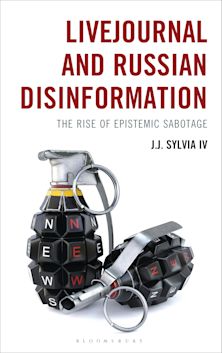- Home
- ACADEMIC
- Politics & International Relations
- Disinformation and Politics of the Internet
- Truth in the Public Sphere
Truth in the Public Sphere
Jason Hannan (Anthology Editor) , David I. Backer (Contributor) , Chris Balaschak (Contributor) , Makeda Best (Contributor) , Charles Bingham (Contributor) , Christopher Gilbert (Contributor) , Lewis A. Friedland (Contributor) , Francis Halsall (Contributor) , Jason Hannan (Contributor) , Thomas Hove (Contributor) , Jeffrey W. Jarman (Contributor) , Spoma Jovanovic (Contributor) , Yacine Kout (Contributor) , Paul Lawrie (Contributor) , Jeanette Musselwhite (Contributor) , Kelly M. O’Donnell (Contributor) , Lisa Silvestri (Contributor) , Shelley Sizemore (Contributor) , Jenny Southard (Contributor)
Truth in the Public Sphere
Jason Hannan (Anthology Editor) , David I. Backer (Contributor) , Chris Balaschak (Contributor) , Makeda Best (Contributor) , Charles Bingham (Contributor) , Christopher Gilbert (Contributor) , Lewis A. Friedland (Contributor) , Francis Halsall (Contributor) , Jason Hannan (Contributor) , Thomas Hove (Contributor) , Jeffrey W. Jarman (Contributor) , Spoma Jovanovic (Contributor) , Yacine Kout (Contributor) , Paul Lawrie (Contributor) , Jeanette Musselwhite (Contributor) , Kelly M. O’Donnell (Contributor) , Lisa Silvestri (Contributor) , Shelley Sizemore (Contributor) , Jenny Southard (Contributor)
This product is usually dispatched within 3 days
- Delivery and returns info
-
Free US delivery on orders $35 or over
You must sign in to add this item to your wishlist. Please sign in or create an account
Description
Has truth become a casualty of America’s increasingly caustic and volatile political culture? Truth in the Public Sphere seeks to understand the significance of truth for the everyday world of human communication. To this end, this book explores the place of truth in several facets of the public sphere: language, ethics, journalism, politics, media, and art. Featuring an international group of contributors from across the humanities and social sciences, this collection is a definitive supplement to theoretical debates about the meaning and status of truth.
Table of Contents
Part I: Discourse & Communication
Chapter 1: Towards an Activist Theory of Language
Chapter 2: Habermas’s Account of Truth in Political Communication
Part II: Ethics and Justice
Chapter 3: One Word Does Not a Whole Story Tell: Contested Truth on a Highway Historical Marker
Chapter 4: The Tragic Action and Revolutionary Intent of Black Lives: The Historical
Chapter 5: Jacques Rancière, Mass Education, and the Linguistic Adventure Around Truth
Part III: Journalism and Politics
Chapter 6: . #NotIntendedToBeAFactualStatement: On Truth and Lies in an Affective Sense
Chapter 7: Motivated to Ignore the Facts: The Inability of Fact-Checking to Promote Truth in the Public Sphere
Chapter 8: Telling the Truth About War in Six Words
Part IV: Visual Media, Art, & Aesthetics
Chapter 9: A Special Kind of Authenticity: The Portrayal of Civilian Deaths and Injuries in Vernacular Soldier Photography
Chapter 10: No Doubt: The Politics of Photography in Antonioni’s Blow-Up
Chapter 11: Light and the Truth in Painting: Thinking Blumenberg’s Absolute Metaphor of Light through Cézanne
About the Contributors
Product details
| Published | Sep 15 2018 |
|---|---|
| Format | Paperback |
| Edition | 1st |
| Extent | 242 |
| ISBN | 9781498530842 |
| Imprint | Lexington Books |
| Illustrations | 4 Tables |
| Dimensions | 9 x 6 inches |
| Publisher | Bloomsbury Publishing |
About the contributors
Reviews
-
In short, the authors of this book succeed in presenting the truth in different contexts communication, but also according to a variety of media (traditional and digital). [Translated from original French]
Communication
-
This is a splendidly feisty, well-researched, passionately argued, and urgently topical book. It stands foursquare in the great tradition of radical social critique that has long played a notable part in U.S. political debate and the revival of which has never been more desperately needed than at present. The editor and contributors do a fine job in dissecting the lies, deceptions, hypocrisies, corruption, criminality, and sheer stupidity that have typified the conduct of successive administrations over the past three decades and more. Writing in the shadow of Donald J. Trump’s emergence as a presidential candidate they anatomize these features of policy and public discourse from a range of well-chosen philosophical perspectives which lay bare the depth and extent of the rot that has done so much to undermine the basic decencies of civic and political life. A courageous, bracingly intelligent collection that deserves—indeed demands—a large readership within and beyond the U.S. academy.
Christopher Norris, distinguished research professor at Cardiff University, Wales
-
Truth in the Public Sphere makes an important and timely intervention in debates about the accountability of political discourse to citizens’ truths. Avoiding the simple realism/relativism binary and the rationalism that has characterized public sphere theory, the contributors (who are top scholars in the field) convincingly make the case for the study of the pragmatics of ‘truth from below.’ This book also features innovative work on the affordances of corporeality, aesthetics, and affect in unconventional and creative ways to theorize and enact truth. It includes compelling case studies from art, history, education, journalism, public relations, mass communication, and rhetorical studies, enabling an interdisciplinary conversation about one of the most urgent questions of our time.
Dana L. Cloud, Syracuse University
-
What is truth? This collection is a good place to stay for an answer. Not to resolve the direct question, but rather to take up important issues that define and test public thought. By starting with the paradox that truth is indefinable yet indispensable, the authors articulate a strong network of concepts and claims for understanding contemporary media practices. Struggle and agreement, facts and authenticity, candor and shamelessness, clarity and affinity: these and other elements of public culture are brought to the light that “truth” promises—even as it also obscures them.
Robert Hariman, Northwestern University


































